Johan Wolthuis Interview
|
This article first appeared in
|
| Written by: Thomas Hauerslev | Issue 47 - December 1996 |
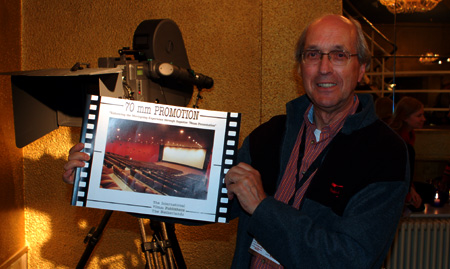 Johan Wolthuis promoting 70mm at the Schauburg cinema, Karlsruhe, Germany, October 2007. Image by Thomas Hauerslev Johan Wolthuis promoting 70mm at the Schauburg cinema, Karlsruhe, Germany, October 2007. Image by Thomas HauerslevJohan C. M. Wolthuis has a passion for 70mm films and founded The International 70mm Association in 1988. In 1994 he organized The 70mm Promotion Tour Los Angeles in an effort to raise the interest in 70mm film. He is a father of three and lives in Arnhem. His favourite film was "Around the World in 80 Days", but is nowadays "Lawrence of Arabia"! Mr. Wolthuis is stepping down as Secretary of The International 70mm Association December 31, 1996. I interviewed him on Wednesday June 5, 1996, at restaurant Ravelinen in Copenhagen, Denmark. By way of introduction, Mr. Wolthuis has written a few lines about his love for the cinema. In January 1954, at the age of fourteen, my mother took me to a cinema for the first time in my home town. I still remember it. They screened an Austrian operetta by Franz Lehar "Das Land des Lächelns" starring Martha Eggerth and Jan Kiepura. I am very grateful to my mother because at that moment she laid the foundation of my dedication to film, and especially to musicals in my life. |
Further in 70mm reading: |
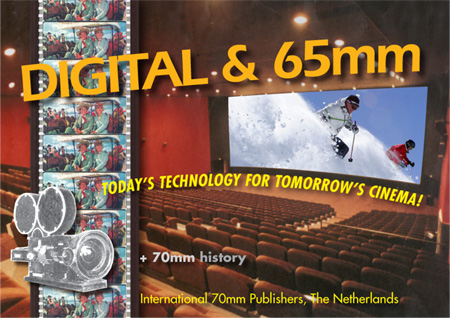 Scheduled for a fall 2009 release "Digital & 65mm - Today's Technology for Tomorrow's Cinema", from "International 70mm Publishers", in The Netherlands, edited and published by Johan Wolthuis Scheduled for a fall 2009 release "Digital & 65mm - Today's Technology for Tomorrow's Cinema", from "International 70mm Publishers", in The Netherlands, edited and published by Johan WolthuisIn September 1954 on the occasion of the 30th jubilee year of MGM, I saw two CinemaScope films for the first time in a special program. "Knights of the Round Table" with Robert Taylor, Ava Gardner and Mel Ferrer and the American musical "Rose Marie, I Love You" with Howard Keel, Ann Blyth and Fernando Lamas. CinemaScope added a widescreen vision to my admiration of films. I nearly saw forty films in 1954, which I think is rather much for a school boy and it did not do much good to my school results at that moment! During 1955, I was lucky to see the first VistaVision motion picture "White Christmas" with Bing Crosby, Danny Kaye and Louis Armstrong. Question: When did you first encounter 70mm? Answer: I think it was in June 1957 when I visited a seaside resort near The Hague. There was special Philips Todd-AO screening with the new 70mm projectors. They screened "The Miracle of Todd-AO" and the first reel of "Oklahoma!" in which Gordon MacRae is riding through a cornfield singing "Oh what a beautiful morning'". I still think of that moment as one of the high points of 70mm. Q: Why did you go? A: I had relatives in The Hague and I loved to go to the cinema. And in those days they showed a lot of films in CinemaScope and other widescreen systems. Todd-AO was new because it was a curved screen and a very large image. |
|
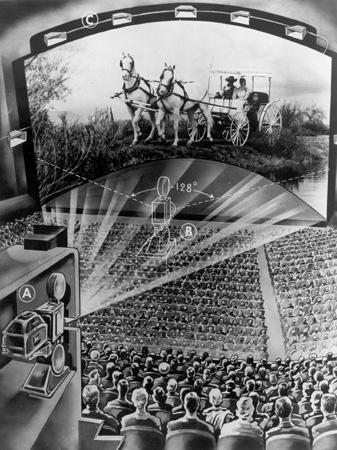 Q: You were attracted to 70mm at once? Q: You were attracted to 70mm at once?A: I think that was the beginning because a few months later in Amsterdam I saw the special equipped cinema playing the famous Michael Todd show "Around the World in 80 Days". From that time on I was convinced (and I still am) that 70mm Todd-AO with 6 channel sound is the ultimate film presentation format for the cinema. There were so many articles in the Dutch press, at the occasion of the premiere of the Mike Todd show, that I could fill a large scrapbook with all the stories around this famous film production and about the showman Todd. A few months after visiting the Amsterdam theatre where the film was screened for more than a year, I learned the screening was not a 70mm print but a special 35mm CinemaScope print from the 24 fps 65mm original [Cinestage]. But nevertheless, the presentation in this theatre, with a wall-to-wall screen, was so impressive that I was not disappointed at all. A year later in 1958, I went to Bruxelles to the World Fair to see Cinerama and Kinopanorama. The following year I saw "South Pacific" when the first Dutch cinema was equipped with Todd-AO. Q: Why was 70mm so good in your opinion? A: Because it gave you an impression of reality. The image was far better than anything I had seen before in cinemas and the sound was so impressive. Q: Do you have any special connection with the film community? Are you a projectionist? A: No, I am an enthusiast. Q: Why did you start The International 70mm Association? A: It began in 1988. I was visiting an IMAX theatre in the south of Holland when I met Mr Willem Bouwmeester. He had a beautiful Grant Lobban BKSTS wall poster with film formats. He told me about the The International Cinerama Society. I told him how impressed I was by 70mm. He liked 70mm too, and asked why I did not start a 70mm society like the Cinerama society? I decided to go on with the idea and began to write letters to magazines in Holland about my idea founding a 70mm association. One magazine took it up and I received reactions from many people who were all interested becoming members of The International 70mm Association. A lot of people joined the 70mm Association, but they were all amateurs. I was disappointed that no professionals inside the film industry were interested. Q: Most of the members from the beginning were projectionists and cinema enthusiasts? A: Yes, the only professional was Mr. Albert Bert and his son Geert Bert from the Kinepolis group in Belgium. They were fans of 70mm too, and wanted to show more 70mm in the future. |
|
 The 70mm Promotion Tour of 1994. Outside Todd-AO Studios, with Johan Wolthuis, Dan Leimeter, Richard Vetter, Darryl Gray and Thomas Hauerslev. Image by Thomas Hauerslev The 70mm Promotion Tour of 1994. Outside Todd-AO Studios, with Johan Wolthuis, Dan Leimeter, Richard Vetter, Darryl Gray and Thomas Hauerslev. Image by Thomas HauerslevQ: What kind of work have you done as secretary of the 70mm association? A: Most of the work consists of writing letters to film companies. I wrote to Columbia Pictures about "Lawrence of Arabia" and received an answer from Mark Hill, who wished me good luck with the 70mm promotion. But that was the last time I heard from him. Q: Have you had any response from the members about your work? A: Only a lot of letters which I had to answer. A lot of people liked my work with the newsletter, but it was mostly answering letters. Q: What was your idea with The 70mm Newsletter? A: To create a kind of institute where members could write and have their letters printed. A combination of publishing letters and news about new films and sometimes an advertisement. I have learned that people love to see an old advertisement of a good 70mm film. That was the original concept of The 70mm Newsletter. Q: How did the idea of a 70mm Promotion Tour begin? A: There was no news about 70mm films, so I wanted to reach the persons who made the decisions in Hollywood. Then came the idea of doing a promotion tour. I discussed this idea many times with Mr. Albert Bert of the Kinepolis Group. Finally he said he wanted to pay. I knew I could not do it alone and I started to look around and finally found you, Thomas. Q: Was the tour a success? A: No, because I believed people would receive us and say "...well OK, we will do the next film in 65mm". But of course, it does not work that way. I would do it a second time, but in a different way. But there will not be a second time. Q: If possible, how would you do it? A: I would discuss it with you about which people we should address and which arguments we should use to tell them why they should do their next film in 65mm. |
|
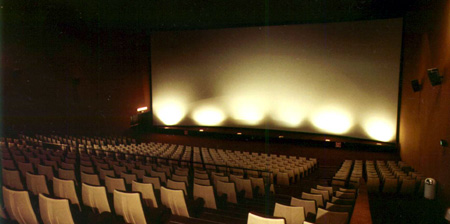 Instrumental to The 70mm Promotion Tour of 1994, the Kinepolis in Belgium and its spectacular screen #9 with it's 26 meter curved 70mm screen. 1992 Image by Thomas Hauerslev Instrumental to The 70mm Promotion Tour of 1994, the Kinepolis in Belgium and its spectacular screen #9 with it's 26 meter curved 70mm screen. 1992 Image by Thomas HauerslevQ: What is your interest today with 70mm? A: I am looking forward to more restorations of old 70mm films. The Americans should do more restorations because we cannot see the old films. There are no good prints anymore of "Porgy and Bess", "South Pacific" or "Can Can". The films should always be available through museums. Today museums keep their old prints. They do not wish to loan them out because they worry about print damage. The prints stay on the shelves until there are no colors left. Q: You have decided to retire as secretary of The International 70mm Association? A: Yes. Q: Why? A: I am not satisfied. I did a lot of work, but it did not pay off. That was not the result I had expected. There is no point in doing so much work anymore. Q: ..but you still enjoy coming to Malmö to see a lot of old 70mm prints? A: (Big laugh) ..yes! I believed that if I am ever going to have a chance to see a lot of old 70mm films, this is the chance. |
|
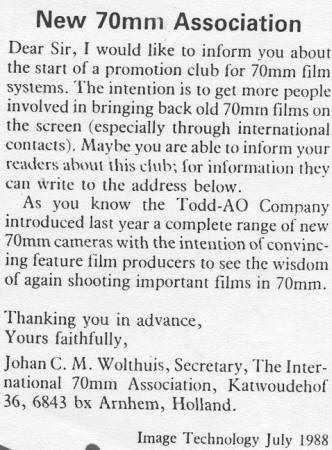 July
1988 issue of Image Technology with the first announcement of The 70mm
Association July
1988 issue of Image Technology with the first announcement of The 70mm
AssociationQ: What would you like to do after your retirement as secretary? A: If I get the chance I would like to promote 70mm to cinema managements and maybe fly to Los Angeles to talk to the managers of film companies. I will also try to write one or two stories which I have toyed with a long time. I will offer them to a film director, but I will only sell them if they are made in 65mm. Q: What do you think should be the future of The 70mm Newsletter? A: I think it is very important because it is the only magazine with a special interest in 70mm and it is very important that managers of the movie companies know the existence of The 70mm Newsletter. Q: What is the future of The International 70mm Association? A: The 70mm Association, in fact, has never existed. We only had one meeting in 1992 in Kinepolis. The 70mm Newsletter is the important thing in this. With members all over the world you can still keep the Association as a promotion club for 70mm film. Members must write more and come with ideas. I was disappointed that no one came up with any ideas of what to do. Q: I wish you a lot of success in the years to come and hope you will carry on for many years. You are still a part of this because you started it. A: Well, I am happy that you say that. It is a nice hobby and it is far more than that. If you look at all those 70mm films made since the 50s, there are a lot of important films. I do not understand why the Americans do not restore old films and keep them in such condition so that they can be shown in cinemas. Because I think cinemas, despite all new inventions, despite computers, Internet and fiber optics, will stay open. There are new cinemas being built everywhere and the cinema interest is also rising. That is a very good thing. Q: Do you think there is hope for 70mm? A: Yes I do. Over the past years we have seen "Far and Away", "Baraka", "Little Buddha" and now "Hamlet". And I hope a lot of people will see them and say "Hey, let's use 65mm again!!!!". Q: Thank you for your time. A: You are welcome. |
|
|
Go: back
- top - back issues Updated 22-01-25 |
